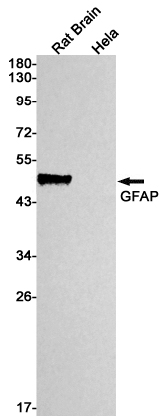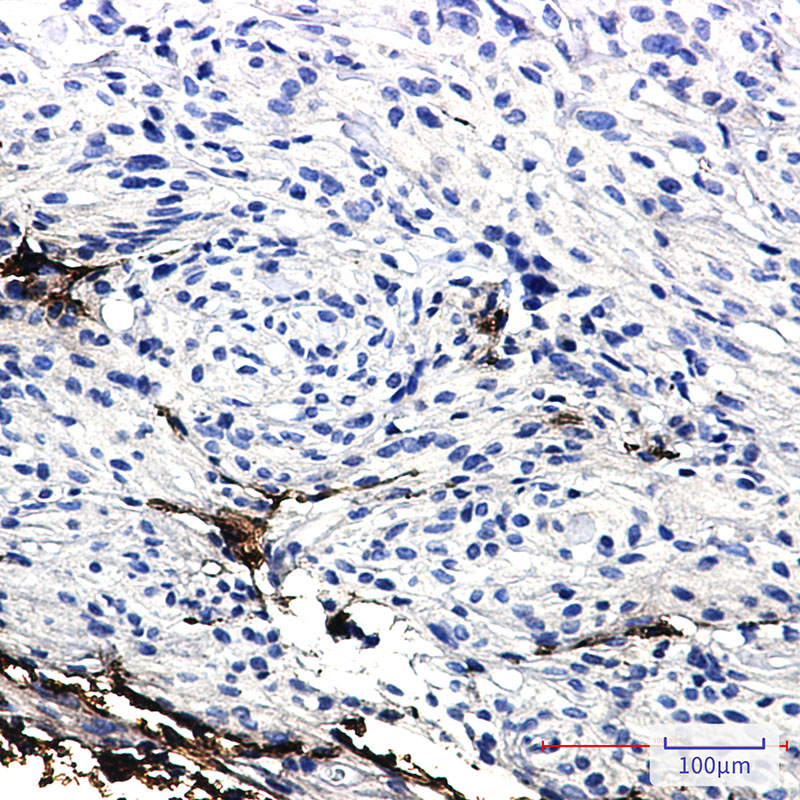

| WB | 1/500-1/1000 | Human,Mouse,Rat |
| IF | 1/20 | Human,Mouse,Rat |
| IHC | 1/50-1/100 | Human,Mouse,Rat |
| ICC | 技术咨询 | Human,Mouse,Rat |
| FCM | 咨询技术 | Human,Mouse,Rat |
| Elisa | 咨询技术 | Human,Mouse,Rat |
| Aliases | GFAP; FLJ45472; cb345; ALXDRD |
| Entrez GeneID | 2670 |
| WB Predicted band size | Calculated MW: 50 kDa; Observed MW: 50 kDa |
| Host/Isotype | Rabbit IgG |
| Antibody Type | Primary antibody |
| Storage | Store at 4°C short term. Aliquot and store at -20°C long term. Avoid freeze/thaw cycles. |
| Species Reactivity | Human,Rat |
| Immunogen | A synthetic peptide of human GFAP |
| Formulation | Purified antibody in TBS with 0.05% sodium azide,0.05%BSA and 50% glycerol. |
+ +
以下是关于GFAP抗体的3篇参考文献及其简要摘要:
1. **文献名称**: "Glial fibrillary acidic protein (GFAP): the major protein of glial intermediate filaments in differentiated astrocytes"
**作者**: Eng, L. F., et al.
**摘要**: 该研究首次系统描述了GFAP作为星形胶质细胞特异性中间丝蛋白的特性,并开发了针对GFAP的单克隆抗体,验证了其在神经组织病理学中对星形胶质细胞活化的标记作用。
2. **文献名称**: "Astrocyte activation and reactive gliosis"
**作者**: Pekny, M., & Pekna, M.
**摘要**: 通过GFAP抗体标记,本文探讨了星形胶质细胞在脑损伤和神经退行性疾病中的活化机制,发现GFAP表达上调与胶质瘢痕形成及神经修复功能密切相关。
3. **文献名称**: "GFAP in health and disease"
**作者**: Middeldorp, J., & Hol, E. M.
**摘要**: 综述了GFAP蛋白及其抗体在正常中枢神经系统中的功能,以及在阿尔茨海默病、多发性硬化等疾病中的异常表达,强调GFAP抗体在疾病诊断和机制研究中的应用价值。
4. **文献名称**: "Antibody-based proteomics for human tissue profiling"
**作者**: Yang, Z., et al.
**摘要**: 利用GFAP抗体进行人脑组织蛋白质组学分析,揭示了不同脑区星形胶质细胞GFAP表达的异质性,并验证了其在神经炎症模型中的动态变化。
(注:以上文献为领域内代表性研究,具体引用时建议核对原始文献信息。)
GFAP (glial fibrillary acidic protein) antibody is a widely used tool in neuroscience and pathology research, primarily targeting the intermediate filament protein GFAP expressed in astrocytes, a major type of glial cell in the central nervous system (CNS). Discovered in 1971. GFAP is a hallmark marker for identifying astrocytes and assessing their reactivity in response to injury, inflammation, or disease. Its expression increases during astrogliosis, a reactive process linked to conditions like Alzheimer’s disease, multiple sclerosis, traumatic brain injury, and brain tumors.
In diagnostics, GFAP antibodies are employed in immunohistochemistry to visualize astrocyte morphology and distribution in tissue samples, aiding in the classification of gliomas (e.g., distinguishing astrocytomas from other tumors). Recent studies also explore GFAP as a biomarker in cerebrospinal fluid or blood for neurological disorders, with elevated levels correlating with conditions like autoimmune encephalitis or neurodegeneration.
Structurally, GFAP forms part of the cytoskeleton, maintaining astrocyte mechanical stability and regulating cellular processes. Its isoforms, generated through alternative splicing, show tissue-specific expression patterns, with implications in disease mechanisms. Research using GFAP antibodies continues to unravel astrocyte heterogeneity, reactive states, and their roles in CNS homeostasis, offering insights into therapeutic targets for neuroprotection and repair.
×